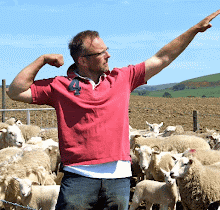All through my “professional” career - which I have stumbled through like a gentleman amateur - I have had it drummed in to me not to be late for meetings. It was reinforced at our Nuffield briefing with the accompanying inference that concerned electrodes and sensitive body parts. I KNOW I shouldn’t be late - and I have been so good recently - but no matter how hard I try, sometimes it just feels like its a natural talent.
And so it came to pass, I was 30 minutes late for a 60 minute meeting with an Emeritus Professor at the Macaulay Land Use Research Institute ...... CRINGE ... fire up the electrodes; I’ll start undressing! I have plenty excuses ... its just when they are transfered from my over active brain to the written word ... they lose a lot of their all-encompassing power. Being late affected our conversation - I was saying sorry all the time and he was busy thinking I was a bit of a pillock.
That said, he gave me a really interesting perspective on land price. I still had the “3 to 5 times farm turnover = land value” multiplier, I encountered in Oz and NZ, etched bold in my brain - I’d almost convinced myself this theory should be enforced through Act of Parliament (or failing that coup d’etat). The Professor had never heard of the multiplier concept (1-0 to me in my strictly controlled, narrow concept, mind game where he isn’t allowed to score).
Yet he simply pointed out the obvious - that farm land is so much more than farming. There are a lot of wealthy people in the UK; that there is a large demand for investments - be they gold bars; works of art or ..... land. Land is emotive, a dream for some, a need for others, to play out expensive hobbies. Effectively the wealth to land area ratio in the UK is fundamentally divergent from "Down Under" and as such investment and leisure buyers have a significantly larger impact.
Also the effect of subsidy in land price is significant. I read somewhere that Alan Greenspan reckoned subsidy was capitalised to form 40% of the land value in certain countries. My professor looked at it differently - half of the total subsidy given out in Scotland finds its way into the capital value of all land. Broken down to an acreage basis this might represent around £1,000 for an arable acre.
Then there is fiscal policy ... taxation ... relief from inheritance ... relief from capital gains. How much does this add to land value? Also, the turnover of land is low and thus supply is poor. But the professor said turnover of land coming on to the market has always been low - sitting at pretty close to 1% of the total area every year, for 150 years.So add to pure farming productivity - investment demand; leisure demand; subsidy distortion, taxation relief and restricted supply.
The attitude of “you’re mad paying that much for land” has been described often, by those that it has been directed at, at the time of their purchase. Without exception it is the “mad” ones that have been proven right. Increasing their equity and going a goal up in their own mind game with the nae-sayers.
But things are different now. In three years, maybe less, land price has as good as doubled in the UK. Surely now it’s mad, surely buying farm land for solely farming purposes should have a special neurosis named after it. Land purchase is now effectively beyond the reach of the typical New Entrant to farming - providing an enforced protection against such mentalness.
In a weird cycle, given the inflated demand for “safe” investments following the credit crisis, maybe the land market has caught the bug that caused the global financial problems in the first place and grown its very own bubble. At some level of value you have to be “mad” to buy land. Yet the bubble still grows - taxation, subsidy, investment needs and emotional wants will keep the bubble cosy, warm and thriving in its very own padded cell.









1 comment:
Good stufff... keep it up. Do I know this Em. Prof, and how come you didn't tell me you were coming to Aberdeen?
Post a Comment